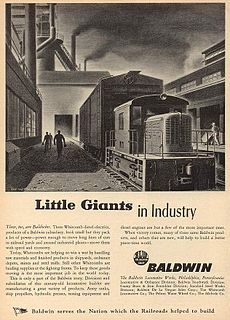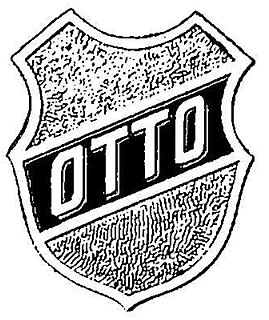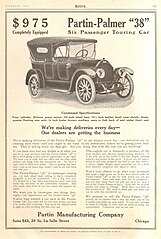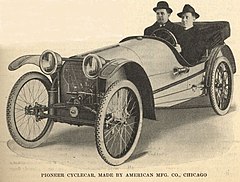The Locomobile Company of America was a pioneering American automobile manufacturer founded in 1899, and known for its dedication to precision before the assembly-line era. It was one of the earliest car manufacturers in the advent of the automobile age. For the first two years after its founding, the company was located in Watertown, Massachusetts. Production was transferred to Bridgeport, Connecticut, in 1900, where it remained until the company's demise in 1929. The company manufactured affordable, small steam cars until 1903, when production switched entirely to internal combustion-powered luxury automobiles. Locomobile was taken over in 1922 by Durant Motors and eventually went out of business in 1929. All cars ever produced by the original company were always sold under the brand name Locomobile.

The Brass Era is an American term for the early period of automotive manufacturing, named for the prominent brass fittings used during this time for such things as lights and radiators. It is generally considered to encompass 1896 through 1915, a time when these vehicles were often referred to as horseless carriages.

The Geo D. Whitcomb Company was founded by George Dexter Whitcomb (1834–1914), of Chicago, Illinois, who started a modest machine shop in 1878, and began the manufacture of coal mining machinery, laying the foundation for the concern that became known as The Whitcomb Locomotive Company.

Otto and Ottomobile were brass era automobile marques of the Otto Gas Engine Works of Philadelphia, Pennsylvania from 1910 to 1912.

The Marion was an automobile produced by the Marion Motor Car Company in Indianapolis, Indiana from 1904 to 1915.

Barley Motor Car Co. was a manufacturer of automobiles in Kalamazoo, Michigan, and Streator, Illinois. It manufactured the Roamer automobile (1916–29) and, briefly, the Barley (1922–24), and the Pennant (1924–25).

The Michigan was a brass era automobile manufactured in Kalamazoo, Michigan from 1904 to 1913 by the Michigan Buggy Company and its subsidiary the Michigan Motor Car Company.

Nyberg was the name of a brass era American automobile built by Henry Nyberg of Chicago, Illinois, in Anderson, Indiana, and Chattanooga, Tennessee from 1911 to 1914.

Scripps-Booth was a United States automobile company based in Detroit, Michigan. Established by James Scripps Booth in 1913, Scripps-Booth produced motor vehicles and was later acquired by General Motors, becoming a division of it, until the brand was discontinued in 1923.

The Matheson was a luxury American automobile manufactured from 1903 to 1912, first in Grand Rapids, Michigan, then Holyoke, Massachusetts and from 1906 in a purpose-built factory in Forty Fort, Wilkes-Barre, Pennsylvania.

Midland Motor Company was an American brass era automobile manufacturer in Moline, Illinois from 1908 to 1913.

The Metz Company was a pioneer brass era automobile maker established by Charles Herman Metz in Waltham, Massachusetts, from 1909 to 1922.

Hatfield Motor Vehicle Company was a pioneer brass era American automobile company, built in Miamisburg, Ohio, in 1907 and 1908.

The W. H. Kiblinger Company and the W. H. McIntyre Company produced Brass Era automobiles in Auburn, Indiana from 1907 to 1915.
The Pierce Engine Company of Racine, Wisconsin, was the manufacturer of the brass era Pierce-Racine automobile. The company was founded in 1892 and produced automobiles from 1904 to 1910.

The Commonwealth Motors Corporation was a luxury auto company that produced cars from 1917 to 1922. The company was founded in Chicago as Partin-Palmer company in 1913, but in 1915 got into financial trouble. So, in 1917, the name was changed to Commonwealth, and production was moved to Joliet, Illinois.

The Ogren Motor Car Company was a vintage era luxury automobile manufacturer based in Chicago, Illinois from 1915 to 1917 and in Milwaukee, Wisconsin from 1920 to 1923.

Leach-Biltwell Motor Company manufactured and distributed the Leach luxury automobile from 1919 to 1924 in Los Angeles, California.
Jonz, Brass Era automobiles and trucks were built by the Jonz Automobile Company from 1908 through 1914 in Beatrice, Nebraska.




















